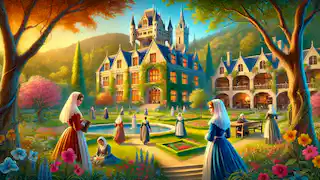In a quaint village in France, surrounded by lush greenery and pristine rivers, there lived a wealthy and mysterious nobleman known as Bluebeard. His nickname derived from the unusual blue hue of his thick beard, which set him apart from everyone else. Bluebeard was known not only for his immense wealth but also for his unsettling presence. Despite his riches, the villagers were wary of him, whispering tales of his deceased wives and his eccentricities.
Bluebeard had been married several times, but each of his wives had mysteriously disappeared, never to be seen again. Some believed that they had left him due to his peculiar behavior, while others speculated more sinister reasons. Nonetheless, Bluebeard was determined to find another wife, and he turned his attention to the daughters of a local nobleman.
This nobleman had two beautiful daughters, Anne and Marie. Anne was the elder, poised and intelligent, while Marie was young, curious, and lively. Despite Bluebeard's reputation, he courted both sisters with lavish gifts and extravagant promises. Anne was skeptical and cautious, but Marie was intrigued by the prospect of wealth and adventure. Bluebeard's persistent courting and the allure of his riches eventually won Marie over, and she agreed to marry him.
After the wedding, Bluebeard took Marie to his magnificent castle, which was filled with splendor and treasures from distant lands. Marie was enchanted by the beauty of her new home and the luxury that surrounded her. Bluebeard treated her kindly and gave her the freedom to explore the castle, except for one small, locked room. He gave her the keys to every door in the castle, with strict instructions never to enter that one forbidden room.
Curiosity gnawed at Marie, but she respected her husband's command and enjoyed her time in the castle, hosting parties and indulging in her new life. However, Bluebeard soon had to leave for a journey, entrusting the castle and all its keys to Marie. He reminded her again not to enter the forbidden room and departed.
Marie couldn't resist the temptation any longer. As soon as Bluebeard was gone, she took the key to the forbidden room and made her way there. Her heart pounded with a mixture of fear and excitement as she unlocked the door. Inside, she discovered a ghastly sight: the floor was stained with blood, and the walls were adorned with the bodies of Bluebeard's previous wives, hanging lifelessly. Horrified, Marie dropped the key, which became stained with blood. She quickly locked the door and fled, hoping to hide her discovery.

Marie tried to wash the bloodstain off the key, but it was enchanted and would not come clean. In a state of panic, she confided in her sister Anne, who had come to visit her. Together, they devised a plan to escape the castle and Bluebeard's impending wrath. Anne sent a message to their brothers, who were soldiers, to come to the castle immediately.
Upon Bluebeard's return, he noticed the bloodstained key and knew that Marie had disobeyed him. In a fit of rage, he demanded to know what she had seen. Trembling, Marie confessed her trespass. Enraged, Bluebeard declared that she must die for her disobedience, just like his previous wives. He raised his sword to strike her down, but Marie pleaded for a moment to pray and say her final goodbyes.

Marie, with quick thinking, stalled for time while waiting for her brothers to arrive. She prayed aloud, hoping that her voice would reach her brothers who were on their way. Bluebeard grew impatient and was about to strike when the doors burst open. Marie's brothers rushed in, swords drawn, and a fierce battle ensued. Bluebeard fought valiantly, but he was ultimately defeated by the combined strength of Marie's brothers.
With Bluebeard dead, Marie was free from the horrors of her husband. She and her sister inherited Bluebeard's wealth and used it to help the people in the village. Marie, having learned the dangers of curiosity and the importance of discernment, lived a life of generosity and kindness, ensuring that the legacy of Bluebeard was one of caution and wisdom.
The tale of Bluebeard became a cautionary story told throughout the region, warning against the dangers of unchecked curiosity and the perils that can come with wealth and power. Marie's story became a symbol of resilience and the triumph of good over evil, a reminder that sometimes, the most unassuming individuals possess the greatest strength and courage.

In the years that followed, the castle stood as a somber reminder of the dark history that had unfolded within its walls. The villagers spoke of the events in hushed tones, passing the tale from one generation to the next. Marie, who had survived the ordeal, became a beloved figure in the community. She dedicated her life to philanthropy, using Bluebeard's wealth to build schools, orphanages, and hospitals, thus transforming her tragic past into a legacy of compassion and generosity.
Marie never remarried, choosing instead to focus on her newfound mission of helping others. She was often seen in the village, wearing simple clothes, her demeanor humble and approachable. The villagers respected her immensely, not only for her charitable work but also for her courage and wisdom. Marie's sister Anne, who had played a crucial role in her rescue, stayed by her side, offering support and companionship.
The sisters became known as the benefactors of the region, their story inspiring countless others. They often spoke to young women about the importance of making wise choices and the value of inner strength. The memory of the dreadful events that transpired in the castle faded over time, replaced by the sisters' enduring legacy of kindness.

As for the castle, it became a place of reflection and education. Marie and Anne converted the dark chambers into libraries and classrooms, where people could come to learn about history, literature, and the arts. The room that once held Bluebeard's gruesome secret was transformed into a memorial, a place where visitors could reflect on the consequences of unchecked power and the importance of truth and transparency.
Marie and Anne lived long, fulfilling lives, surrounded by the gratitude and admiration of those they had helped. The castle, once a symbol of fear, became a beacon of hope and enlightenment. The story of Bluebeard, though filled with darkness and tragedy, ultimately served as a lesson in resilience, courage, and the power of redemption.

In the end, Marie and Anne's story was not just about survival but about transformation. They turned their painful experiences into a force for good, proving that even in the darkest of times, there is the potential for light and positive change. The legacy of Bluebeard, transformed by the bravery and generosity of the sisters, became a testament to the enduring power of hope and the human spirit.
Marie and Anne's efforts had a profound impact on the region, transforming not only the physical landscape but also the social fabric of the community. Their work led to a renaissance of education and culture in the village, as more people gained access to knowledge and opportunities they had never imagined. The castle, now bustling with activity and learning, became a symbol of hope and a center of cultural renaissance.
The sisters established scholarships for young people to pursue their education, regardless of their background or financial means. They invited scholars, artists, and thinkers from across the land to share their knowledge and skills with the villagers. The castle's once eerie halls were now filled with the sounds of laughter, debates, and the scratching of quills on parchment. Marie and Anne believed that education and enlightenment were the greatest tools to combat ignorance and tyranny, and they dedicated their lives to spreading these values.
As time passed, the sisters aged gracefully, beloved by all who knew them. Marie's hair turned silver, and Anne's once sharp features softened, but their spirits remained as vibrant as ever. They continued to be active in their community, always seeking new ways to help and inspire others. The village flourished under their guidance, becoming a place known for its culture, education, and progressive values.
In their later years, Marie and Anne began to compile their memoirs, chronicling their journey from the fateful encounter with Bluebeard to their current lives as philanthropists and educators. They wanted to leave behind a record of their experiences and the lessons they had learned, hoping that future generations could learn from their story. Their memoirs were filled with insights on resilience, the importance of community, and the power of compassion.
The day eventually came when the sisters passed away, peacefully in their sleep, within a few days of each other. The entire village mourned their loss, but their legacy lived on. The castle was transformed into a museum and a school, named in honor of the sisters. Marie and Anne's final resting place was adorned with a simple yet elegant monument, inscribed with a message that encapsulated their philosophy: "In the face of darkness, let your light shine brightly."
The story of Bluebeard, once a dark tale of curiosity and caution, had been rewritten by the courage and kindness of two remarkable women. Marie and Anne's lives had shown that even the most sinister situations could be overcome with bravery, wisdom, and a dedication to helping others. The sisters had taken a story of fear and turned it into one of hope and inspiration, leaving an indelible mark on their community and beyond.
As the years passed, people from far and wide came to the village to learn about the legendary sisters who had turned tragedy into triumph. The museum and school continued to educate and inspire, drawing visitors and students eager to learn about the transformative power of kindness and education. Marie and Anne's story became a timeless tale, passed down through the generations, reminding everyone that no matter the circumstances, it is always possible to make
a positive difference in the world.
The legacy of Marie and Anne stands as a testament to the power of the human spirit to overcome adversity and create lasting change. Their lives, marked by courage, compassion, and an unwavering commitment to the greater good, continue to inspire people to this day. The village they left behind is a living testament to their values, a place where education, culture, and community thrive. And so, the tale of Bluebeard, transformed by the resilience of two sisters, lives on as a beacon of hope and a lesson in the enduring power of goodness and light.

















